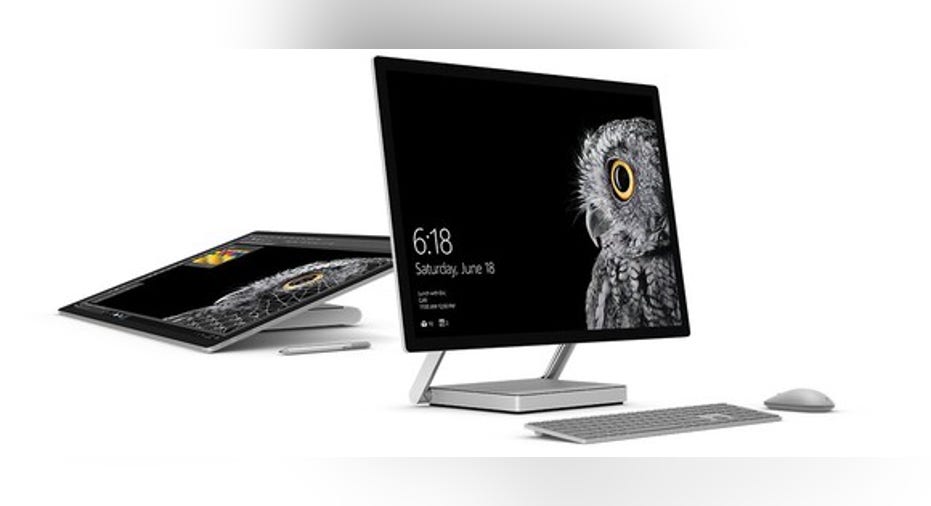Will Microsoft's Surface Studio Crush Apple's Mac Business?

Microsoft (NASDAQ: MSFT) recently unveiled the Surface Pro Studio, a sleekall-in-one PC which can be adjusted to a near-flat orientation for digital design purposes. The 28" 4,500 x 3,000 display has a whopping 13.5 million pixels -- 63% more pixels than a 4K television -- on a 10-point multi-touch touchscreen.
The Surface Pro Studio comes with the Surface Pen, which works with other Surface devices, and the new Surface Dial. The Surface Dial is a physical dial which attaches to the Surface Pro Studio's screen to help graphic designers adjust various settings.
Image source: Microsoft.
The base model, which costs $2,999, is powered by a sixth-gen quad-core Intel Core i5 processor, an Nvidia GeForce GTX 965M GPU, 8GB of RAM, and a 1TB hybrid drive -- defying the notion that PCs must become cheaper to address waning demand. They also indicate that Microsoft is coming after Apple's (NASDAQ: AAPL) Macs in the premium PC market.
What's Microsoft trying to do?
When Microsoft launched the first Surface devices in 2012, it wasn't trying to develop a big new hardware business like Apple's. It was merely trying to steer the PC market toward 2-in-1 devices which showcased the desktop and "Metro" modes of Windows 8. It was also trying to shake the perception of Windows devices as boxy, utilitarian devices which couldn't measure up to Apple's streamlined aesthetics.
That push worked, and Windows PC makers flooded the market with 2-in-1 devices which carved out a growing niche between tablets andfull-fledged desktops. Enterprise customers also bought more Surface devices, since they enabled them to upgrade aging desktops with more mobile solutions without losing access to legacy Windows software.
Microsoft then continued expanding the Surface brand with the Surface Book, which set the form factor bar even higher for laptop and 2-in-1 makers. With the Surface Pro Studio, Microsoft is likely trying to do the same for the all-in-one market, which is frequently overlooked and clumped together with traditional desktops. That push seems to be working -- Dell just teasedan all-in-one device which shares the same design principles as the Surface Pro Studio.
The new Surface Book. Image source: Microsoft.
Microsoft probably doesn't care if it sells more of its own Surface devices, or if it helps Windows OEMs sell more Surface-inspired devices. That's because most of its revenue still comes from sales of Windows licenses. So as long as Windows-powered devices dominate the PC market, Microsoft will maintain a defensible platform against iOS and Android devices.
Why Apple should start worrying
The comparisons between Microsoft's new Surface devices and Apple's Macs look pretty dismal for the latter. The base models of Microsoft's new Surface Book and Apple's new MacBook Pro both cost about $1,500, but theSurface Book gets 12 hours of battery life compared to theMacBook Pro's 10 hours. A pricier version of the Surface Book adds a whopping 16 hours of battery life. The Surface Book also offers a full detachable touchscreen, while the new MacBook Pro merely adds a "Touch Bar" across the topof the keyboard.
We see the same form factor confusion when we compare the iPad Pro to the iMacs -- the former mimics the Surface's hybrid touchscreen approach with iOS, but the latter rigidly sticks with the mouse-operated OS X. That's a stubborn design choice, since third-party companies have been producing add-on touchscreens foriMacs for years.
Apple's hardware design is stuck between two form factors, because iOS and OS X remain distinctly separate. By comparison, Microsoft's strategy of using Windows as an "all-in-one" OS for PCs, tablets, and phones gives hardware makers more freedom to create 2-in-1 and all-in-one devices. For many customers -- especially Apple's dedicated demographic of graphic designers -- the Surface Pro Studio likely represents what the iMacs should have already become.
The key takeaway
Microsoft's new Surface devices, along with the clones that they will inspire, won't deliver a knockout punch to Apple's Mac business, whichaccounted for 12% of its top line last quarter. But Apple's Macs are definitely losing steam -- shipments dropped 14% annually last quarter as revenue fell 17% to $5.7 billion. Meanwhile, Microsoft's Surface revenue surged 38% annually to$926 million last quarter.
Therefore, if Apple doesn't present a clearer vision for the future of the Mac soon, it could fall behind the tech and innovation curve as Microsoft surges ahead with more daring products. We already saw this happen with the HoloLens, and the Surface Pro Studio is another indicator that Microsoft isn't afraid to invest more heavily in new ideas.
A secret billion-dollar stock opportunity The world's biggest tech company forgot to show you something, but a few Wall Street analysts and the Fool didn't miss a beat: There's a small company that's powering their brand-new gadgets and the coming revolution in technology. And we think its stock price has nearly unlimited room to run for early in-the-know investors! To be one of them, just click here.
Leo Sun has no position in any stocks mentioned. The Motley Fool owns shares of and recommends Apple and Nvidia. The Motley Fool owns shares of Microsoft and has the following options: long January 2018 $90 calls on Apple and short January 2018 $95 calls on Apple. The Motley Fool recommends Intel. Try any of our Foolish newsletter services free for 30 days. We Fools may not all hold the same opinions, but we all believe that considering a diverse range of insights makes us better investors. The Motley Fool has a disclosure policy.



















